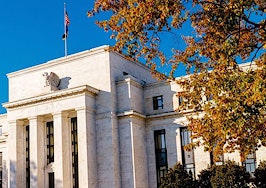We are likely to be in a sustained rise in interest rates (sometimes just writing that sentence means that the rise has stopped for good), but even a sustained one has its plateaus, and at the end of this week, the credit markets have stabilized.
The 10-year Treasury note in July 2016 fell to 1.37 percent (mortgages: 3.375 percent). Five months later, in December: 2.57 percent (mortgages: 4.25 percent). Then nine months of modest retracement downward, last September back to 2.05 percent (mortgages: 3.875 percent). Followed since by the fast run to 2.90 percent (mortgages 4.75 percent), a little better at this week’s end.
That’s almost double in 18 months. Only 1.5 percentage points, but the highest long-term rates since 2011. The question now is when will the 10-year break through 3.00% going higher, putting that number “five” back into the mortgage vocabulary for the first sustained time since the Great Recession. Market consensus (of course, often wrong): “when,” not whether.
The largest part of the move thus far is the markets catching up (not the Fed) after a long period of denial. The Fed is certain to continue to raise the overnight cost of money (the Fed funds rate), and long rates are on alert. From here, everything depends on inflation. Since we have not had a multi-point, multi-year rise in inflation in 35 years, a review of inflation mechanics is in order.
- Inflation is defined as too much money chasing too few goods and services.
- “Too much money” has been very well prevented by global central banks for the last 35 years.
- Inflation will not get started or sustain without corresponding growth in incomes. Not now, not yet.
- Inflation hell is a “wage-price spiral,” in which the two chase each other upward. Today we couldn’t get that going if we tried. Right-siders say that 1970s spiral was the fault of unions and cost of living adjustments, but the greater enabler was the absence of international wage competition. Today we are hammered by that competition.
- Deficits? This new binge by Republicans and Democrats together? The Treasury selling more bonds, of course, produces upward pressure, but hard to isolate and likely a small impact. Treasury borrowing crowds out other borrowers of lesser credit rating, who must pay higher rates. There is no linkage between deficits and inflation.
- …except if the Fed monetizes and overstimulates the economy. The Fed is doing the reverse, now. “Overheating” is a real risk, but every valid metric from WW II to 1995 has broken down, the whole world growing fast but inflation underheating. GDP can grow way out of the bounds of “productivity” without inflation, and far below “capacity” with inflation (“stagflation”).
- An overheated housing market has been central to all prior overheatings. Not now. Housing is chilled by tough credit standards and high demand only in urban areas.
- “Falling dollar?” Ignore that. Sure, a truly weak dollar forces up prices of imports, but that’s 1970s-think, global and domestic economies then were rigid compared to today’s ultra-e-flexibility.
- Today the two hugely powerful suppressants of inflation — nearly tipping the world into deflation and depression — are as active as ever: global trade and IT. Competition is inescapable.
So, where’s the friggin’ fire? If we don’t have any of the propellants of inflation, and the dampers are still on, what is the panic in bonds about? And the Fed’s plans for a quarter-point death march ahead?
We don’t know. The Fed doesn’t know, and the financial markets don’t know. The best we can do is to bracket the probabilities.
Start with “how high, how fast.” The Fed is determined to defend its 2 percent inflation target. The Fed can get behind and have to catch up, a prescription for up-fast too-high, and back-down-fast. The 10-year maybe to 4 percent briefly, mortgages pressing 6 percent, followed by a refi party.
The other side of the high-probability bracket is continuing “normalization,” the Fed in search of the “neutral policy rate known as r* (pronounced “ar-star”) defined as the Fed funds rate spread above inflation which is neither stimulative nor a drag.
The Fed does not know the location of r*, in part because it moves. In the 1970s to offset oil and inflexibility, r* might have been a 4 percent premium above inflation — and the Fed’s flinch from that altitude encouraged the deadly spiral. Just last year Yellen mused that r* might now be zero — a normalized Fed funds rate might be the rate of inflation itself.
Given all of the inflation-suppressants in place, guess r* to be at 1 percent, which is what the Fed is doing with its damned-little-dot scattergram of future intentions. Two- or three-year target for Fed funds: 3 percent. But then a secondary unknown: what will be the response of long-term rates to that level of Fed funds? If inflation stops at 2 percent, and the Fed stays tough, the 10-year might not get above 3.5 percent or even so high, mortgages mid-fives. Normalized.
If that happens, somebody on Wall Street might say something nice about the Fed.
The 10-year T-note in the last five years, everyone in markets staring at the 3.00 percent double-top at the end of 2013:

The Fed-sensitive 2-year T-note, same five years showing two things: how vastly variable long-term rates are versus the Fed, and the stall in the last two weeks hints that markets are ahead of themselves in both Fed- and inflation-fear:

The National Federation of Independent Business has surveyed its members since 1974, one of the longest useful series on the US economy. All following charts are NFIB, apologies for inconsistent format. Since ’74 the NFIB surveys have been an excellent real-time indicator of the US economy — until Election Day 2016 when it departed the economy for politics. Its membership is heavily right-side, which is fine and normal, but our economic-political relationship today is not normal, unusual experiments underway. The election spike in optimism could not be more plain:

The underlying survey components tell a different story, worth watching. Last month “optimism” reached an all-time high — not at all reflected by survey components. “Earnings” are the one happy spike, and with the tax bill giveaway to businesses, one would hope so. But, does that change indicate a shift in the real economy?

This is the “sales” component. Yes, there’s a nice jump in “actual” (bold line) in 2017, but nothing fancy compared to the 2012 spurt, and still tepid compared to 1974-2006:

“Prices” are still a falling trend. “Compensation” is rising steadily, and if it breaks above the long-term trend, one of the best inflation-precursor indicators:

Question asked and answered. No:

Lou Barnes is a mortgage broker based in Boulder, Colorado. He can be reached at lbarnes@pmglending.com.












